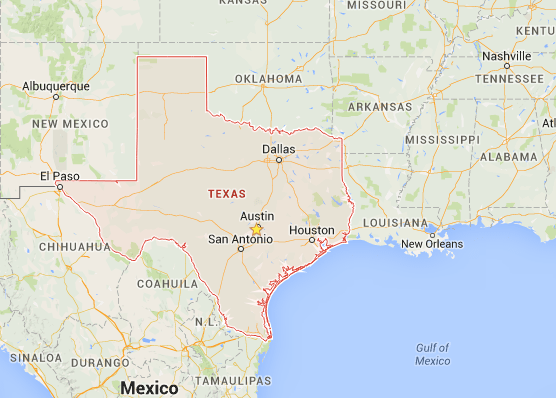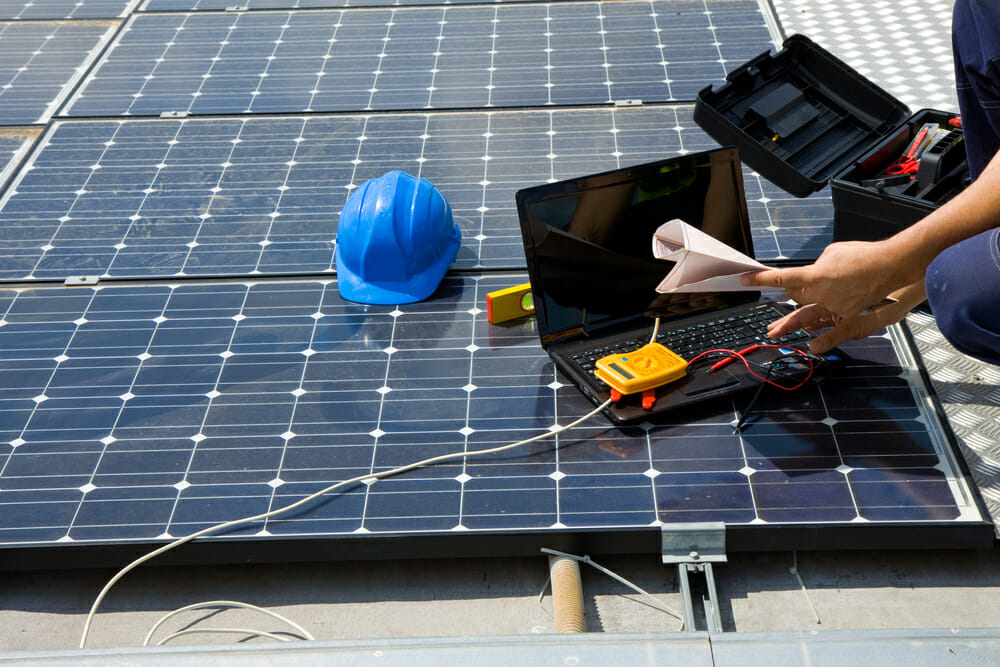How to Use the Solar Calculator
The best way to learn about local rebates, your home’s energy potential, and your eventual return on investment is to use our ModSun Solar Cost Calculator (see above). Enter your home address in the box, then click Check My Roof. You’ll get an instant picture of your roof’s productivity, your average energy expenses, and installation costs in your area—whether you decide to buy or loan. We’ll also provide system size recommendations and information about rebates and incentives you may be eligible for. Just select More Info under each purchasing strategy to learn more, and then connect with a solar pro.
Solar Panels in Texas
With large oil and natural gas reserves, Texas might seem like an unlikely place for progressive renewable energy policies to flourish, but that is simply not the case. The state’s vast geographic landscape, and its relatively low population density, make creating local sources of power an attractive economic option. On-site energy production systems like solar, reduce the cost of new transmission lines in the state, as well as the distance that coal, oil, or natural gas need to travel to meet energy demands.
In addition to the cost savings when compared to fossil fuel systems, setting up a solar energy system is more affordable now than ever. The cost of solar systems in Texas has decreased by 50% in the past five years thanks to expanded and more efficient manufacturing, advanced technology, industry economies of scale, and legislation that encourages local utilities to support the adaptation of renewable energy technologies.
Texas has a Renewable Portfolio Standard which requires 10,000 megawatts of renewables to be installed throughout the state by 2025. At least 500 megawatts must come from non-wind sources, like solar. Texas surpassed the 2025 target in 2009 when it reached 13,359 megawatts of renewable energy capacity–generating roughly 10% of the state’s current energy use.
Adopting solar energy systems in Texas makes good economic sense. Texas has the largest electricity demand in the U.S. combined with urban air quality concerns, frequent droughts, a growing population, and a talented workforce. Solar energy systems offer high-value electric supply necessary to meet those demands, zero carbon dioxide emissions, very low water use, unprecedented affordability, as well as creating numerous jobs throughout the state.
Solar Capacity in Texas
According to the recently released US Solar Market Insight Report, in early 2015, Texas added 41.6 megawatts of utility-scale solar, along with 4.3 megawatts of residential, and 3 megawatts of commercial, bringing its statewide total to 379 megawatts–enough to power more than 66,000 homes. Texas trails only five states California, Nevada, New York, North Carolina, and Massachusetts in term of new solar capacity. Texas is now on pace to install more than 200 megawatts of new solar capacity this year, nearly three times more than was installed in 2013.
Today, there are 404 solar companies in Texas, employing more than 7,000 people, including manufacturers, contractors, project developers, distributors, and installers. From an environmental perspective, solar installations in Texas are helping to offset more than 410,000 metric tons of harmful carbon emissions, which is the equivalent of removing 86,000 cars off the state’s roads and highways, or not consuming 46 million gallons of gasoline.
Notable Solar Energy Systems Throughout the State
- Camp Mabry in Austin, Texas has a 150 kilowatt carport structure. The project was partially funded by a grant offered through the American Recovery and Reinvestment Act and administered by the Texas State Energy Conservation Office. Soldiers, staff, and visitors to the military installation now have protection from the sun while also benefiting from the clean, renewable energy it generates.
- Alamo 4 Solar Farm was completed in 2014 and has the capacity to generate 39 megawatts of electricity–enough to power over 4,200 Texas homes.
- At 30 megawatts, the Barilla Solar Project in Webberville is the first merchant solar project in the United States. With no long term electricity contract, the project from First Solar and Austin Energy represents a landmark in the production of cost-efficient solar energy.
- Several large retailers in Texas have gone solar, including REI, Applied Materials, Kohl’s, Campbell’s Soup, and Target. IKEA has also installed one of the largest corporate photovoltaic systems in the state with 1,633 kilowatts of solar capacity at their location in Round Rock.
Relevant Legislation on Solar in Texas
As of September 1, 2015, legislation signed into law by Governor Greg Abbott will enable more Texas homeowners to install solar panels. Residential developments with more than 50 homes can no longer ban or restrict homeowners from installing solar panels, even while new homes are still being built. This new law eliminates a loophole in existing law that allowed developers and homeowners associations to forbid the installation of solar panels on individual homes–considered eyesores, if the housing development was still considered, “in progress,” with no end date in sight.
Available Rebates for Solar in Texas
To help Texans adopt renewables, the state offers numerous incentives. While other states have adopted legislation requiring utilities to offer net metering to their residents, utilities in Texas have the option to offer net metering, but are not mandated to offer it. Net metering is a system in which solar panels or other renewable energy generators are connected to a public-utility power grid and surplus power is transferred onto the grid, allowing customers to offset the cost of power drawn from the utility.
Solar incentives are offered at the utility, county, state and federal level. These solar incentives can take various forms including solar tax credits, up front solar rebates, net metering, or solar production incentives.The eligibility and rules for each incentive program can vary greatly.
- Federal tax credits grant a personal tax credit of 30% of the total expenses, which include installation of residential solar-electric systems, solar thermal systems, fuel cells, and labor expenses. Solar electric systems and solar thermal heaters have no maximum incentive. If there is excess federal tax credit, it may be carried over to the subsequent taxable year only if it surpasses tax liability. The federal tax credit is in force through 2016.
- The Federal Energy Conservation Subsidy Exclusion requires public utilities to provide residential purchasers of solar energy systems with an exemption of 100% of energy conservation subsidies. The overall worth of an installation or renewable utility regardless of the energy conservation capacity, will be excluded from the buyer’s gross income. Customers who participate in a utility company’s energy conservation program may be given a reduced rate of electricity utilized or a nonrefundable credit of the price of electricity on the customer’s monthly electric bill.
- Energy-Efficient Mortgages is a federal loan program that enables homeowners to utilize energy-efficient mortgages to either supplement or completely fund renewable energy systems.
- Property Assessed Clean Energy (PACE) Financing allows home, building, and property owners to finance renewable energy and energy-efficiency projects by placing a assessment on the land. The amount financed often is paid via property taxes on a yearly basis until the system is paid off. In Texas, the PACE statutes are carried out by local governments. The only way to find out if a local government offers PACE financing in Texas is to call them or visit their website. Not all local governments offer PACE financing.
- Net Metering is available to subscribers of Austin Energy (commercial and residential) with renewable energy systems. Qualifying solar systems include: solar photovoltaics and solar thermal. The systems must not exceed 20 kilowatts to be eligible. The excess electricity generated by a renewable energy system that is purchased by Austin Energy is represented in the form of credit on the customer’s next electric bill.
- Texas Tax Code 171.056 provides a franchise tax exemption for any entity that is solely engaged in the business of manufacturing, selling or installing qualifying solar energy devices, as defined by Sec. 171.107, or certain component parts of such devices.
Will Investing in Solar Panels Increase My Property Taxes?
No. Texas offers a property tax exemption (Texas Tax Code 11.27) that allows the owners of commercial, industrial, and residential properties to take an exemption from taxation (using form 50-123) for the amount of the appraised value of the property that increases as a result of the installation or construction of a solar energy system. “Solar” is broadly defined to include a range of biomass technologies including: passive solar space heat, solar water heat, solar space heat, solar thermal electric, solar thermal process heat, photovoltaics, storage technologies, and solar pool heating.
Does Texas Allow Solar Leasing?
Yes. With a solar lease you don’t have to pay the high upfront cost of panels, equipment, and installation. Instead of paying for a solar system, you pay a one-time up-front payment or opt for a fixed monthly amount to install solar panels and use the electricity they generate. Similar to leasing a car, you can choose to purchase your solar electric system at the end of your lease and many companies will even let you transfer your lease to a new address if you move.
Solar leasing in Texas makes up a very small percentage of the ownership structure due to the lack of a statewide incentive program. Most solar leasing that’s been done in Texas, has been done on a prepaid basis–meaning one initial payment made up-front, similar to a purchase. This payment takes into account any rebates and incentives, like the 30% federal tax credit, as well as the depreciation on the equipment that can be taken by the Leasing Company. In general, a prepaid lease is 50%-60% cheaper than a purchase, depending on available rebates etc. However if you plan to stay in your home for more than 10 years and can benefit from the 30% federal tax credit it usually makes better financial sense to purchase your own system.
Incorporating Solar Into Your Home
The first thing you want to do when deciding whether or not a solar energy system is right for you is to check with your Homeowner’s Association (HOA) to find out whether there are any restrictions on solar panels in your neighborhood. Remember, despite recent legislation, the installation of solar systems in housing developments with less than 50 homes is still at the discretion of the HOA. Next you’ll want to work with a reputable company to determine what kind of solar energy system—solar hot water, solar pool heater, solar panels, or building integrated photovoltaics–will work best for your home and to meet your energy needs. You’ll need to obtain building permits. Similarly, building, electrical, and plumbing codes may also apply. That said, residential solar power systems do not employee radical building techniques, and most jurisdictions have building codes that fully embrace solar energy technology. Most solar professionals include the price for permits into their cost estimate.

